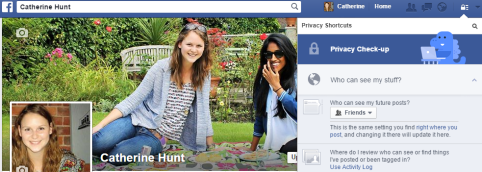Topic 2: The one or many faces of . . . ?
Who are you?
Who are you online?
Are you the same to everyone?
‘Online identity’?
Is “problematic in that its definition is so broad” (Warburton, 2010, p.8).
Marcus et al’s (2006, p.1014) definition was the first I found; “actively constructed presentation of oneself”.
While this is useful, Krotoski (2012) suggested the complexity of balance, through managing an “aggregated version of offline past, the online present and combined future”.
I understand it as a spider’s web. We have a unitary identity (spider) and able to develop this identity (web), by engaging in social networks that reflect who we are offline. We see ourselves and others, bounded by these connections.
Even so, ‘online identity’ may or may not reflect our whole identity because they can be “adopted or claimed in cyberspace” (Technopedia, 2014).
So . .
1. Is this FAKE ‘online identity’?
2. How much information should we DISCLOSE to ensure a genuine ‘online identity’?
3. How can we insure SECURITY and PRIVACY?
My Facebook account answers the above:
1. I use my real name/Accept and engage with real friends.
2. I choose certain information to disclose and I won’t ever reveal traceable information e.g. address.
3. Security = password protected account & Privacy = privacy short-cuts link (see below) to manage the access of information of ‘friends’ and lists them accordingly.

While, maintaining one ‘online identity’ may be simple, easy to engage with, and reflects who I say I am. Multiple ‘online identities’ are also possible.
Palfrey and Gasser (2008, p.33) argued that we are living under an Internet Age Paradox:
“Such a wealth of possibilities to recreate oneself in an array of virtual platforms, yet we are now more likely to be bound more tightly to a unitary identity in the physical world. Sometimes these identities are sustained as separate and kept distinct from one another, but they are likely to converge”
But is this true today?
Multiple ‘online identities?
Lewman, (2012) argued that identity segmentation provides us with:
- Anonymity
- Creativity
- Separation e.g. Private vs Personal
- Freedom to explore other identities to suit audiences/purposes
While, social networks are seen as a gateway for unitary and multiple ‘identity’ creation, every website and person will have a picture of you or yourselves. So, it’s completely up to you how you create, manage, maintain and engage with either your ‘online identity’ or ‘online identities’.
[Words: 398]
References:
1. DiMicco, J., & Millen, D. (2007) Identity Management: Multiple presentations of self in Facebook. [Online] Available at: http://www.davidmillen.com/publications/group2007-dimicco.pdf (Accessed: 21 October 2014)
2. Krotoski, A. (2012) Online Identity : is authenticity or anonymity more important? The Guardian. [Online] Available at: http://www.theguardian.com/technology/2012/apr/19/online-identity-authenticity-anonymity (Accessed: 22 October 2014)
3. Lewman, A (2012) in Online Identity : is authenticity or anonymity more important? The Guardian. [Online] Available at: http://www.theguardian.com/technology/2012/apr/19/online-identity-authenticity-anonymity (Accessed: 22 October 2014)
4. Marcus, B., Machilek, F., Schutz, A (2006) ‘Personality in cyberspace: personal websites as media for personality expressions and impressions’ Journal of Personality and Social Psychology. 90(6). p.1014-1031.
5. Palfrey, J and Gasser, U. (2008) Born Digital: Understanding the first generation of digital natives. London. Basic: reprint edition. p.33
6. Technopedia. (2014) ‘What is digital identity’. [Online]. Available at: http://www.techopedia.com/definition/23915/digital-identity (Accessed: 22 October 2014)
7. Visual.ly. (2011) ‘Individuals and their online identities’ (Infographic) [Online]. Available at: http://visual.ly/individuals-and-their-online-identity(Accessed: 24 October 2014)
8. Warburton, S. (2010) ‘Identity Matters’. London. King’s College London. [Online] Available at: http://digitaldisruptions.org/rhizome/wp-content/uploads/2010/06/rhiz08_DigitalIdentityMatters.pdf (Accessed: 23 October 2014) p.8

